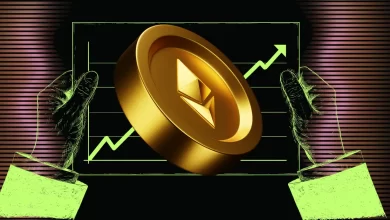Crypto Market Capitalization Surges Past $3.4 Trillion


The cryptocurrency market has seen a significant surge, with the total market capitalization increasing by 10% to reach $3.4 trillion. This milestone reflects renewed investor confidence and bullish momentum across the crypto space. Concurrently, U.S. spot Bitcoin exchange-traded funds (ETFs) recorded substantial weekly net inflows exceeding $920 million, indicating strong institutional and retail interest in Bitcoin exposure through regulated investment vehicles.
The rally in the crypto market cap aligns with several catalysts, including positive geopolitical developments, such as the partial easing of U.S.-China trade tensions, and growing institutional adoption. Bitcoin, trading around $103,000, has been a key driver, with its market cap comprising over 56% of the total crypto market. The $920 million in ETF inflows underscores the increasing appeal of Bitcoin as a “digital gold” asset, particularly amid economic uncertainties and tariff-related market volatility. Notable ETFs, such as BlackRock’s iShares Bitcoin Trust (IBIT), have led the inflows, with IBIT alone managing over $56 billion in assets.
Altcoins like Ethereum, Solana, and XRP have also contributed to the market cap growth, with DeFi platforms like Unichain and Hyperliquid showing explosive gains in total value locked (TVL). Stablecoins on Solana hit a record $13.11 billion market cap, further signaling robust liquidity in the ecosystem. However, the market remains volatile, with Bitcoin facing resistance around $96,000–$97,000, and some investors hedging through short-Bitcoin products.
Register for Tekedia Mini-MBA edition 17 (June 9 – Sept 6, 2025) today for early bird discounts. Do annual for access to Blucera.com.
Tekedia AI in Business Masterclass opens registrations.
Join Tekedia Capital Syndicate and co-invest in great global startups.
Register to become a better CEO or Director with Tekedia CEO & Director Program.
This data suggests a broader risk-on sentiment, supported by macroeconomic factors and institutional participation, but investors should remain cautious of potential corrections given the market’s sensitivity to regulatory and economic shifts. The 10% surge in the crypto total market cap to $3.4 trillion and the $920 million in weekly net inflows into Bitcoin ETFs signal significant implications for the cryptocurrency ecosystem, while also highlighting a growing divide between traditional finance (TradFi) and decentralized finance (DeFi), as well as between institutional and retail investors.
The $920 million in Bitcoin ETF inflows reflects strong institutional demand, particularly through vehicles like BlackRock’s IBIT, which manages over $56 billion in assets. This trend suggests that institutions view Bitcoin as a hedge against inflation, currency devaluation, and geopolitical uncertainty, especially amid tariff threats and U.S.-China trade tensions. ETFs provide a regulated, accessible entry point for traditional investors, reducing reliance on crypto exchanges and potentially stabilizing Bitcoin’s price volatility over time.
However, institutional dominance could centralize influence over Bitcoin’s market dynamics, raising concerns among crypto purists who value decentralization. The $3.4 trillion market cap, with Bitcoin comprising over 56%, indicates a maturing market with growing liquidity. Stablecoins on Solana reaching a $13.11 billion market cap further bolster this, enabling seamless transactions in DeFi ecosystems.
Altcoins like Ethereum, Solana, and XRP, alongside DeFi platforms like Unichain and Hyperliquid, are diversifying the market, reducing Bitcoin’s historical dominance and signaling broader use cases for blockchain technology. This maturation could attract more regulatory scrutiny, as governments seek to balance innovation with investor protection and financial stability.
The rally aligns with a risk-on sentiment, partly driven by optimism around U.S. economic policies under a new administration and easing trade tensions. Bitcoin’s appeal as “digital gold” grows in an environment of potential fiat currency devaluation and tariff-driven inflation. However, the market’s sensitivity to macroeconomic shifts—such as Federal Reserve rate decisions or unexpected regulatory crackdowns—poses risks of sharp corrections, especially with Bitcoin testing resistance at $96,000–$97,000.
Retail Investor FOMO
The market cap surge and ETF inflows are likely fueling retail investor enthusiasm, with platforms like Coinbase and Binance reporting increased trading volumes. Bitcoin ETFs represent a bridge between crypto and traditional finance, allowing investors to gain exposure without navigating decentralized wallets or exchanges. This integration boosts legitimacy but ties crypto to TradFi’s infrastructure, subject to centralized oversight and custodial risks.
DeFi advocates argue that ETFs undermine crypto’s ethos of decentralization, as they rely on custodians and regulated entities. Platforms like Unichain and Hyperliquid, with soaring TVL, emphasize self-custody and permissionless finance, appealing to those wary of centralized control.
Institutions, with their large capital pools, are driving ETF inflows and shaping market narratives. Their involvement stabilizes prices but risks marginalizing retail investors, who may face higher entry barriers in a market increasingly influenced by Wall Street. Retail investors, active on platforms like X, continue to fuel altcoin rallies and meme-driven tokens. However, their speculative behavior contrasts with institutions’ strategic allocations, creating a divide in investment philosophies and market impact.
This gap could widen if institutions push for more regulated products, potentially sidelining retail-driven projects or triggering regulatory clampdowns that disproportionately affect smaller investors. The ETF boom highlights a centralized narrative, where crypto is packaged as a TradFi asset class. Meanwhile, DeFi’s growth—evident in Solana’s stablecoin surge and Ethereum’s scaling solutions—emphasizes decentralization and financial sovereignty.
This ideological split could influence future development, with centralized crypto products gaining mainstream traction while decentralized protocols cater to niche, ideologically driven communities. The $3.4 trillion market cap and $920 million in ETF inflows underscore crypto’s growing mainstream acceptance, driven by institutional capital and macroeconomic tailwinds.
However, they also expose a deepening divide between TradFi and DeFi, as well as between institutional and retail investors. While these dynamics signal a maturing market, they raise questions about crypto’s decentralized roots and the balance of power in its ecosystem. Investors should monitor regulatory developments, institutional flows, and DeFi innovation to navigate this evolving landscape, as the interplay between these forces will shape crypto’s trajectory in 2025 and beyond.






